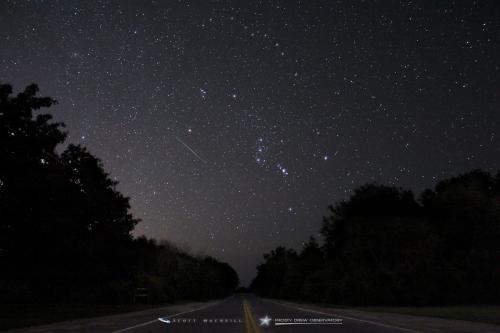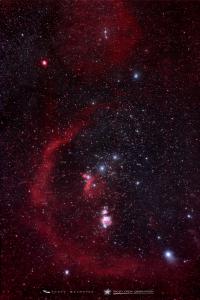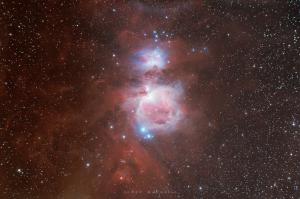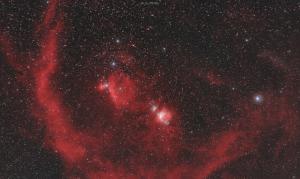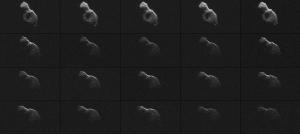Celebration of Space - November 27, 2020
Over the past week and a half, the International Space Station (ISS) has put on a stunning display of evening passes over the United States. Here in New England, we have had several nights of clear sky conditions, making for a beautiful addition to our seasonal revelries, with passes continuing through the holiday weekend and through next week. Unfortunately, there aren’t any amazing passes, like we had this past week, in store for the coming nights. Regardless, the station will be visible on a nightly basis. Here are several notable passes for this weekend and coming week:
Fri, Nov 27 starting at 5:38 pm in the NW, rising to 16°, heading towards the NNE and into orbital sunset.
Sat, Nov 28 starting at 4:50 pm in the WNW, rising to 19°, heading towards the NNE
Sun, Nov 29 starting at 5:40 pm in the NW, rising to 14° into orbital sunset.
Mon, Nov 30 starting at 4:52 pm in the NW, rising to 15°, heading towards the NNE
Tue, Dec 1 starting at 5:42 pm in the NNW, rising to 16° into orbital sunset
Wed, Dec 2 starting at 4:55 pm in the NNW, rising to 15°, heading towards the NE
Thu, Dec 3 starting at 5:44 in the NW, rising to 23° into orbital sunset.
These pass times are applicable to Southern New England and generally acceptable for the entire Northeast. For pass times specific to your location, visit NASAs Spot the Station. Now put these times on your calendar and set your alarm. Step outside nightly and catch a view of humanity’s only continuously inhabited space-based residence passing over.
As we make the plunge into full out winter holiday mode, a very familiar constellation, probably one of the most known, moves into the early night sky, and serves as a reminder that the winter season is nearly upon us. The constellation Orion – The Hunter is the most sought after constellation from visitors to the Frosty Drew Observatory. Every night that we open, regardless of the time of year, we are asked to point out the constellation Orion. Why is it so popular? We really can’t answer that affirmatively. Though we speculate a few different subtleties that, together, may make it that popular.
For one, Orion actually looks like what it is supposed to represent (The Hunter). Many, if not most, constellations take some serious imagination to see what they represent, with some just not pulling it off. Think of the constellation Vulpecula – The Fox, or Canis Minor which is one of Orion’s dogs. Yeah nothing! Secondly, Orion is sky high during the earliest nights of the year, making it more accessible for everyone to see, and it kicks in during the holiday season, which for many, is a memory maker. The final speculation is that Orion has some notable stars. Orion’s Belt stands out so clearly among all other stars in the region. The bright red supergiant Betelgeuse is the brightest star in Orion. Regardless of the reason, Orion is certainly a fan favorite of our visitors, and our astronomers as well.
Enter Messier 42 – The Orion Nebula, or often referenced as The Great Nebula in Orion. This is one of two naked-eye visible star forming nebulae in the Northern Hemisphere. The other being Messier 8 – The Lagoon Nebula in the constellation Sagittarius. The Orion Nebula, is also the closest site of massive star formation to the Solar System. This stunning nebula resides at nearly 1,400 light years distant, and spans over 25 light years in diameter. Inside the nebula over 700 newborn stars exist, with enough hydrogen to form over 2,000. The nebula is considered a diffuse nebula as it is comprised of both a reflection nebula, which are parts of the hydrogen gas cloud that are illuminated by bright starlight from the more massive young stars residing in the nebula, and an emissions nebula, which are parts of the hydrogen gas cloud that are being ionized by intense ultraviolet radiation originating from the massive stars inside the nebula. The hydrogen ions will recombine with free flowing electrons, putting them into an excited state. When they return to a ground state, they release a bit of energy as a photon. The reflection nebula is white-blue, with the emissions nebula being magenta-red. Check out this image of the Orion Nebula that Scott captured this month at Frosty Drew Observatory.
The Orion Nebula is the center point of the larger Orion Molecular Cloud Complex, which covers nearly the entire constellation of Orion. This is a vast region of star forming nebula, dark nebula, reflection nebula, and a supernova remnant called Barnard’s Loop. The entire complex is connected and has some very notable celestial objects, including the Flame Nebula, the Horsehead Nebula, Orion’s Belt, and more. Check out this image of the Orion Molecular Cloud Complex that James captured at Frosty Drew Observatory in December 2019-January 2020.
It’s easy to see why the constellation Orion is held in such high esteems by so many people. It truly is a constellation of so many amazing objects to observe and study. Growing up looking to the stars, I have certainly made a connection with Orion and the holidays, and I remember many Xmas Eve midnight walks, looking to Orion, thinking about my place in the Universe. If you haven’t had a chance to observe the Orion Nebula in the Frosty Drew Observatory primary telescope, you are missing out! Our telescope offers an amazing view of this young star forming region, one that you will not quickly forget. So ring in the holidays with the constellation Orion, either just looking out your window or skylight, scanning with your binoculars, or by stopping in at Frosty Drew Observatory; and welcome the wintertime sky with a little holiday cheer.
This weekend, we will have two Near Earth Asteroid (NEA) passes about 48 hours apart from each other. Both passes will be quite close, with one passing at a fraction of the distance of the Moon from Earth. The first NEA to pass by is Asteroid 2000 WO107, which is rather large, measuring 0.32 miles in diameter. This NEA will make its closest approach to Earth just after midnight ET on November 29, 2020 at a distance of 2.67 million miles distant (11.19 times the distance of the Moon). This object is large enough to be seen easily in the Frosty Drew Observatory telescope! The second NEA to pass is called Asteroid 2020 SO. This object is much smaller, measured at around 6-12 meters in diameter. It will make its closest approach to Earth on December 1, 2020, at a distance of 58,200 miles, which is 0.2 times the distance of the Moon from Earth. Neither of these asteroids pose an impact threat, so no doomsday scenario here. Even though 2020 SO is much closer, it is so much smaller that it will be difficult to view in our telescope. At Frosty Drew Observatory, we may attempt to capture images of 2000 WO107. If we do, we’ll post them to our Facebook over the next week.
With the crazy shopping frenzied weekend upon us, everyone gets into giving (or maybe getting) mode, marking one of the American holiday traditions. A recent tradition that has caught on is the Cyber Monday tradition, and the Giving Tuesday tradition. Small 501(c)(3) organizations, like Frosty Drew, rely on generous support from donors on days like Giving Tuesday to continue our mission. But this year has been exceptionally difficult. With significant restrictions on our events and programs, due to the global pandemic, we are finding ourselves in a rather large deficit. Though we are surviving, which is to say a lot considering the fate of so many wonderful organizations and businesses that had to shut their doors for the last time this year. At Frosty Drew Observatory and Science Center, our mission is a message of hope for so many people that are unsure that they can do amazing things. Fulfilling our mission is so important to us. We see more people trying to put each other down these days, rather than lifting each other up. There is so much hope in the stars, a hope that has driven so many regular individuals to do amazing things. When you support Frosty Drew Observatory, you are enabling us to continue our mission. We don’t know who will be the first human to set foot on Mars, but we do know that they are walking around on Earth right now. What are they thinking at this moment? Perhaps they don’t think they will do something amazing in their life, or that they may not be the right person to truly make a difference. Maybe all this person needs is to hear that they CAN DO IT! Our mission is not to do great things, but to inspire others to do great things. Your support allows us to carry on this mission. We are so thankful for those who have supported us over the years, and for those who continue to do so. You are amazing people, and we love you for it! As you wrap up your weekend of frenzy, we ask you to consider Frosty Drew Observatory and Science Center in your giving, donate today. Thank You!
- Author:
- Scott MacNeill
- Entry Date:
- Nov 27, 2020
- Published Under:
- Scott MacNeill's Columns

